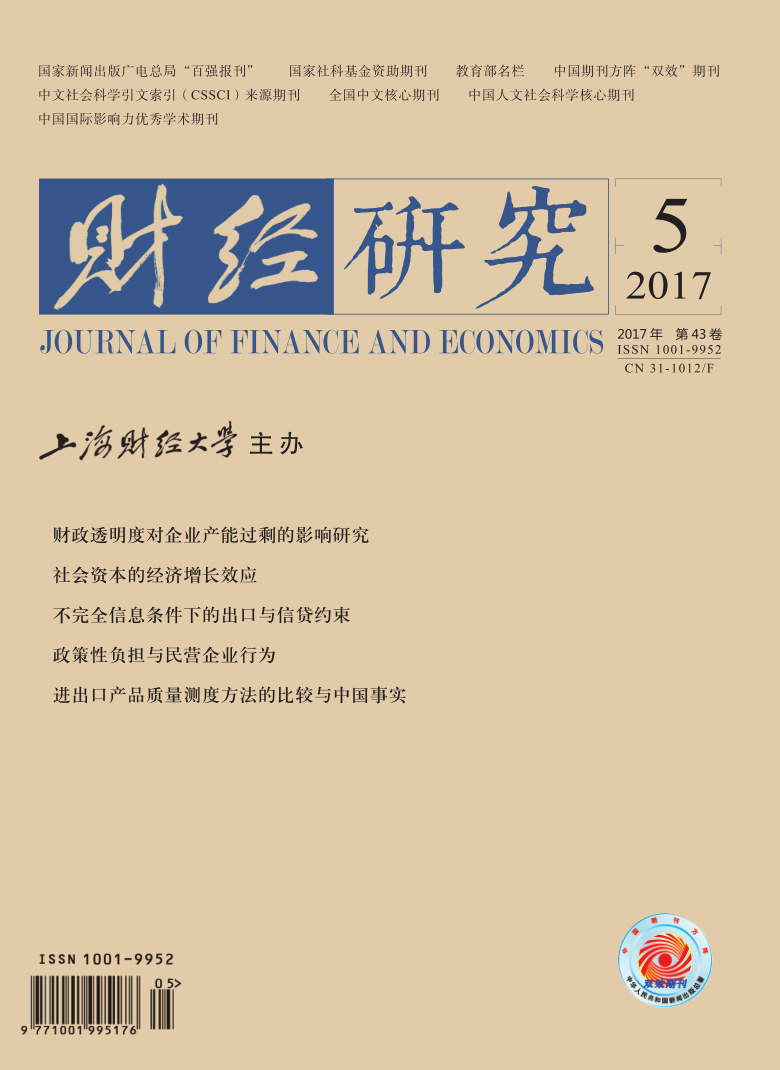文章讨论了在"银行-企业"不完全信息条件下,国内企业和出口企业面对的信贷约束为何不同。由于企业的生产率等信息对于银行而言属于内部信息,银行为了保持激励相容,会向企业提供少于企业所需最优数量的贷款。这种贷款的约束构成了企业面对的信贷约束。出口企业的运输时间越长,相比国内企业就会面临更紧的信贷约束。使用中国企业的数据验证这一理论,我们发现,对中国企业而言,出口业务占比越大、运输时间越长、生产率差异越大,企业面临的信贷约束也就越紧。
不完全信息条件下的出口与信贷约束——来自中国的理论与证据
摘要
参考文献
1 Ahn J. A theory of domestic and international trade finance[R]. IMF Working Paper No. 11/262, 2011.
2 Amiti M, Weinstein D E. Exports and financial shocks[J]. The Quarterly Journal of Economics, 2011, 126(4): 1841-1877. DOI:10.1093/qje/qjr033
3 Beck T. Financial development and international trade: Is there a link?[J]. Journal of International Economics, 2002, 57(1): 107-131. DOI:10.1016/S0022-1996(01)00131-3
4 Behrens K, Corcos G, Mion G. Trade crisis? What trade crisis?[R]. CEPR Discussion Paper No. DP7956, 2010.
5 Berman N, de Sousa J, Martin P, et al. Time to ship during financial crises[R]. NBER Working Paper No. 18274, 2012.
6 Bernard A B, Jensen J B, Redding S J, et al. Firms in international trade[J]. Journal of Economic Perspectives, 2007, 21(3): 105-130. DOI:10.1257/jep.21.3.105
8 Brandt L, van Biesebroeck J, Zhang Y. Creative accounting or creative destruction? Firm-level productivity growth in Chinese manufacturing[J]. Journal of Development Economics, 2012, 97(2): 339-351. DOI:10.1016/j.jdeveco.2011.02.002
9 Buch C M, Kesternich I, Lipponer A, et al. Real versus financial barriers to multinational activity[R]. University of Nottingham, 2008.
10 Cai H, Liu Q. Competition and corporate tax avoidance: Evidence from Chinese industrial firms[J]. The Economic Journal, 2009, 119(537): 764-795. DOI:10.1111/ecoj.2009.119.issue-537
11 Chaney T. Liquidity constrained exporters[R]. University of Chicago, 2005.
12 Chor D, Manova K. Off the cliff and back? Credit conditions and international trade during the global financial crisis[J]. Journal of International Economics, 2012, 87(1): 117-133. DOI:10.1016/j.jinteco.2011.04.001
13 Claessens S, Tzioumis K. Measuring firms' access to finance[R]. Access to Finance: Building Inclusive Financial Systems, Organized by the Brooking Institution and the World Bank, 2006.
15 Dai M, Maitra M, Yu M. Unexceptional exporter performance in China? The role of processing trade[J]. Journal of Development Economics, 2016, 121:177-189. DOI:10.1016/j.jdeveco.2016.03.007
16 Egger P, Keuschnigg C. Access to credit and comparative advantage[R]. Discussion Paper, 2011.
17 Ellison G, Glaeser E L, Kerr W R. What causes industry agglomeration? Evidence from coagglomeration patterns[J]. American Economic Review, 2010, 100(3): 1195-1213. DOI:10.1257/aer.100.3.1195
18 Feenstra R C, Hanson G H. Ownership and control in outsourcing to China: Estimating the property-rights theory of the firm[J]. The Quarterly Journal of Economics, 2005, 120(2): 729-761.
19 Feenstra R C, Li Z, Yu M. Exports and credit constraints under incomplete information: Theory and evidence from China[R]. NBER Working Paper No. 16940, 2011.
20 Greenaway D, Guariglia A, Kneller R. Financial factors and exporting decisions[J]. Journal of International Economics, 2007, 73(2): 377-395. DOI:10.1016/j.jinteco.2007.04.002
21 Gross T, Verani S. Financing constraints, firm dynamics, and international trade[R]. Finance and Economics Discussion Series No. 2012-68, 2012.
22 Harrison A E, McMillan M S. Does direct foreign investment affect domestic credit constraints?[J]. Journal of International Economics, 2003, 61(1): 73-100. DOI:10.1016/S0022-1996(02)00078-8
23 Heckman J, Vytlacil E. Instrumental variables methods for the correlated random coefficient model: Estimating the average rate of return to schooling when the return is correlated with schooling[J]. The Journal of Human Resources, 1998, 33(4): 974-987. DOI:10.2307/146405
24 Héricourt J, Poncet S. FDI and credit constraints: Firm-level evidence from China[J]. Economic Systems, 2009, 33(1): 1-21. DOI:10.1016/j.ecosys.2008.07.001
25 Kletzer K, Bardhan P. Credit markets and patterns of international trade[J]. Journal of Development Economics, 1987, 27(1-2): 57-70. DOI:10.1016/0304-3878(87)90006-X
26 Levchenko A A, Lewis L T, Tesar L L. The collapse of international trade during the 2008-2009 crisis: In search of the smoking gun[R]. NBER Working Papers No. 16006, 2010.
27 Levinsohn J, Petrin A. Estimating production functions using inputs to control for unobservables[J]. Review of Economic Studies, 2003, 70(2): 317-341. DOI:10.1111/roes.2003.70.issue-2
28 Lu D. Exceptional exporter performance? Evidence from Chinese manufacturing firms[R]. Job Market Paper, 2010.
29 Manova K, Wei S-J, Zhang Z. Firm exports and multinational activity under credit constraints[R]. NBER Working Paper No. 16905, 2011.
30 Manova K. Credit constraints, heterogeneous firms, and international trade[J]. Review of Economic Studies, 2013, 80(2): 711-744. DOI:10.1093/restud/rds036
31 Matsuyama K. Credit market imperfections and patterns of international trade and capital flows[J].Journal of the European Economic Association, 2005, 3(2-3): 714-723. DOI:10.1162/jeea.2005.3.2-3.714
32 Melitz M J. The impact of trade on intra-industry reallocations and aggregate industry productivity[J]. Econometrica, 2003, 71(6): 1695-1725. DOI:10.1111/ecta.2003.71.issue-6
33 Muûls M. Exporters and credit constraints. A firm-level approach[R]. NBB Working Paper No. 139, 2008.
34 Olley G S, Pakes A. The dynamics of productivity in the telecommunications equipment industry[J]. Econometrica, 1996, 64(6): 1263-1297. DOI:10.2307/2171831
36 Qiu L D. Credit rationing and patterns of new product trade[J]. Journal of Economic Integration, 1999, 14(1): 75-95.
37 Verani S. Aggregate consequences of firm-level financing constraints[R]. Job Market Paper, University of California, 2011.
38 Yu M J. Processing trade, firm productivity, and tariff reductions: Evidence from Chinese products[R]. CCER Working Paper No. E201006, 2011.
引用本文
RobertC.Feenstra, 李志远, 余淼杰. 不完全信息条件下的出口与信贷约束——来自中国的理论与证据[J]. 财经研究, 2017, 43(5): 44–64.
导出参考文献,格式为:
上一篇:社会资本的经济增长效应





 8039
8039  6198
6198

